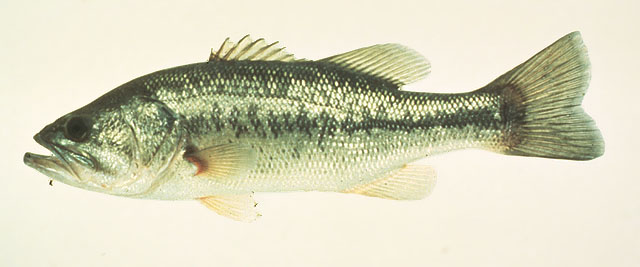| Centrarchidae (Sunfishes) |
| 97 cm TL (male/unsexed); max.weight: 10 kg; max. reported age: 23 years |
|
benthopelagic; freshwater; pH range: 7 - 7.5; dH range: 10; depth range 0 - 6 m |
| North America: St. Lawrence - Great Lakes, and Mississippi River basins from southern Quebec to Minnesota and south to Gulf; Atlantic and Gulf drainages from North Carolina to Florida and to northern Mexico. The species has been introduced widely as a game fish and is now cosmopolitan. Several countries report adverse ecological impact after introduction. |
|
Dorsal spines (total): 10-10; Dorsal soft rays (total): 11-14; Anal spines: 3-3; Anal soft rays: 10-12; Vertebrae: 30-32. Description: Mouth large; maxillary extending beyond the eye; small caniniform teeth in bands on jaws (Ref. 40476, 52193). Dorsal fin with 9-10 spines and 12-13 soft rays; dorsal fin membrane deeply cleft between spinous and soft-rayed sections; anal fin with 3 spines and 9-11 soft rays; pelvic fins not joined by a membrane; caudal fin emarginate or rounded; caudal fin with 17 rays (Ref. 2196, 40476, 52193). Lateral line complete, 58-69 scales, 6-8 between lateral line and first dorsal spine, no scales on base of dorsal or anal fins (Ref. 52193). Colouration: Green to olive dorsally, light green on flanks, milk-white to yellow ventrally, with a black band running from the operculum to the base of the caudal fin; a connected series of short, dark olive green vertical bars forms an irregular band along body, 2 or 3 broad olive stripes radiate behind eye (Ref. 40476, 52193). |
| Inhabit lakes, ponds, swamps, and backwaters and pools of creeks, and small to large rivers (Ref. 86798). Usually found over mud or sand and common in impoundments (Ref. 5723). They prefer quiet, clear water and over-grown banks. Adults feed on fishes, crayfish and frogs; young feed on crustaceans, insects and small fishes. Sometimes cannibalistic. They don't feed during spawning; as well as when the water temperature is below 5°C and above 37°C (Ref. 30578). Builds nest at 25 mm-203 mm deep (Ref. 1998). An introduced species in Europe reported to avoid fast-flowing waters and to occur in estuaries with a salinity up to 13 ppt (Ref. 59043). Popular game fish in North America. Preyed upon by herons, bitterns, and kingfishers (Ref. 1998). Excellent food fish (Ref. 1998). |
|
Least Concern (LC); Date assessed: 14 November 2018 Ref. (130435)
|
| potential pest |
Source and more info: www.fishbase.org. For personal, classroom, and other internal use only. Not for publication.

